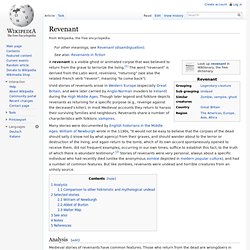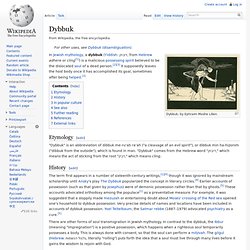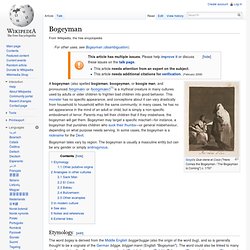

Revenant. A revenant is a visible ghost or animated corpse that was believed to return from the grave to terrorize the living.[1] The word "revenant" is derived from the Latin word, reveniens, "returning" (see also the related French verb "revenir", meaning "to come back").

Vivid stories of revenants arose in Western Europe (especially Great Britain, and were later carried by Anglo-Norman invaders to Ireland) during the High Middle Ages. Though later legend and folklore depicts revenants as returning for a specific purpose (e.g., revenge against the deceased's killer), in most Medieval accounts they return to harass their surviving families and neighbours. Goblin. Ghoul. A ghoul is a folkloric monster or spirit associated with graveyards and consuming human flesh, often classified as undead.
The oldest surviving literature that mention ghouls is likely One Thousand and One Nights.[1] The term was first used in English literature in 1786, in William Beckford's Orientalist novel Vathek,[2] which describes the ghūl of Arabian folklore. Demon. In Ancient Near Eastern religions as well as in the Abrahamic traditions, including ancient and medieval Christian demonology, a demon is considered an unclean spirit, sometimes a fallen angel, the spirit of a deceased human, or a spirit of unknown type which may cause demonic possession, calling for an exorcism.

In Western occultism and Renaissance magic, which grew out of an amalgamation of Greco-Roman magic, Jewish demonology and Christian tradition,[2] a demon is a spiritual entity that may be conjured and controlled. Terminology[edit] The Greek term does not have any connotations of evil or malevolence. In fact, εὐδαιμονία eudaimonia, (literally good-spiritedness) means happiness. The supposed existence of demons remains an important concept in many modern religions and occultist traditions. Dybbuk box. Legend and history[edit] The term "Dybbuk box" was first used by Kevin Mannis as a description in the Item Information for an eBay auction to describe it as the subject of an original story (not the story for the film), detailing supposedly true events which he considered to be related to the box.

Mannis, a writer and creative professional by trade, owned a small antiques and furniture refinishing business in Portland, Oregon at the time.[1][2] According to Mannis' story, he bought the box at an estate sale in 2001. It had belonged to a Holocaust survivor of Polish origin, named Havela, who had escaped to Spain prior to her immigration to the United States. Havela purposely sealed a dybbuk inside the box after it contacted her and her friends while performing a seance with a homemade oracle board.[3] Numerous owners of the box have reported that strange phenomena accompany it. Dybbuk. Dybbuk, by Ephraim Moshe Lilien.

In Jewish mythology, a dybbuk (Yiddish: דיבוק, from Hebrew adhere or cling[1]) is a malicious possessing spirit believed to be the dislocated soul of a dead person.[2][3] It supposedly leaves the host body once it has accomplished its goal, sometimes after being helped.[3] Etymology[edit] Bugbear. Bogeyman. Goya's Que viene el Coco ("Here Comes the Bogeyman / The Bogeyman is Coming") c. 1797 A bogeyman (also spelled bogieman, boogeyman, or boogie man, and pronounced /bʊɡimæn/ or /boʊɡimæn/)[1] is a mythical creature in many cultures used by adults or older children to frighten bad children into good behavior.

This monster has no specific appearance, and conceptions about it can vary drastically from household to household within the same community; in many cases, he has no set appearance in the mind of an adult or child, but is simply a non-specific embodiment of terror. Parents may tell their children that if they misbehave, the bogeyman will get them. Dokkaebi. Dokkaebi (Korean: 도깨비), sometimes known as Duduri (Korean: 두두리) is a common word for a type of spirit in Korean folklore or fairy tales.

They are old things transformed at night Characteristics[edit] Different versions of the Korean Dokkaebi mythology assign different attributes to them. In some cases they are considered harmless but nevertheless mischievous, usually playing pranks on people or challenging wayward travellers to a ssireum (Korean wrestling) match for the right to pass. Vampire. Vampires are mythical beings who subsist by feeding on the life essence (generally in the form of blood) of living creatures In folkloric tales, undead vampires often visited loved ones and caused mischief or deaths in the neighbourhoods they inhabited when they were alive.

They wore shrouds and were often described as bloated and of ruddy or dark countenance, markedly different from today's gaunt, pale vampire which dates from the early 1800s. Although vampiric entities have been recorded in most cultures, the term vampire was not popularised until the early 18th century, after an influx of vampire superstition into Western Europe from areas where vampire legends were frequent, such as the Balkans and Eastern Europe,[1] although local variants were also known by different names, such as vrykolakas in Greece and strigoi in Romania. Etymology Folk beliefs Description and common attributes Creating vampires The causes of vampiric generation were many and varied in original folklore.